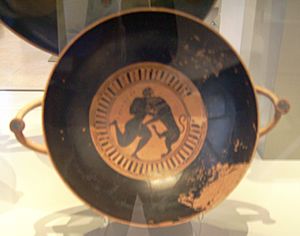Merrythought cup facts for kids
The Merrythought cup is a special kind of ancient Greek drinking cup. Experts use this name to describe a unique type of kylix that came from Attica, a region in Greece where the famous city of Athens is located.
What is a Merrythought Cup?
The Merrythought cup gets its name from the British word "wishbone." A wishbone is the V-shaped bone found in birds, often broken by two people making a wish. The handles of this cup look a lot like a wishbone!
How it was Made
This special cup likely grew out of simpler, everyday cups that were usually made from wood in the countryside. The Merrythought cup was a more fancy and polished version of these wooden cups.
Unique Features
Merrythought cups have some very interesting features that make them stand out:
- Smooth Shape: Unlike most other ancient Greek cups, the Merrythought cup doesn't have a clear break or line between its lip (the rim you drink from) and the main body of the cup. It flows smoothly from top to bottom.
- Wishbone Handles: The handles are shaped like an oblong (stretched-out) wishbone. They also have a small knob, or bump, on the curve of the handle. Most other cups have handles that form a simple half-circle, but not this one!
- Tall Handles: Another unusual thing is that the handles reach higher than the top edge of the cup itself. This is very rare for ancient Greek drinking cups.
Decoration and Style
Most Merrythought cups were covered in a shiny black coating called slip. Sometimes, artists would add thin red stripes on the foot (the base of the cup) or inside the cup. This style of decoration was similar to what was seen in other parts of ancient Greece, like East Greece.
The main body of the cup is almost perfectly round, like half of a sphere. The first artist known to decorate these cups using the black-figure style was an artist known as the C Painter. In the black-figure style, artists painted figures in black on the red clay background, then added details by scratching lines into the black paint.
See also
 In Spanish: Copa Merrythought para niños
In Spanish: Copa Merrythought para niños


